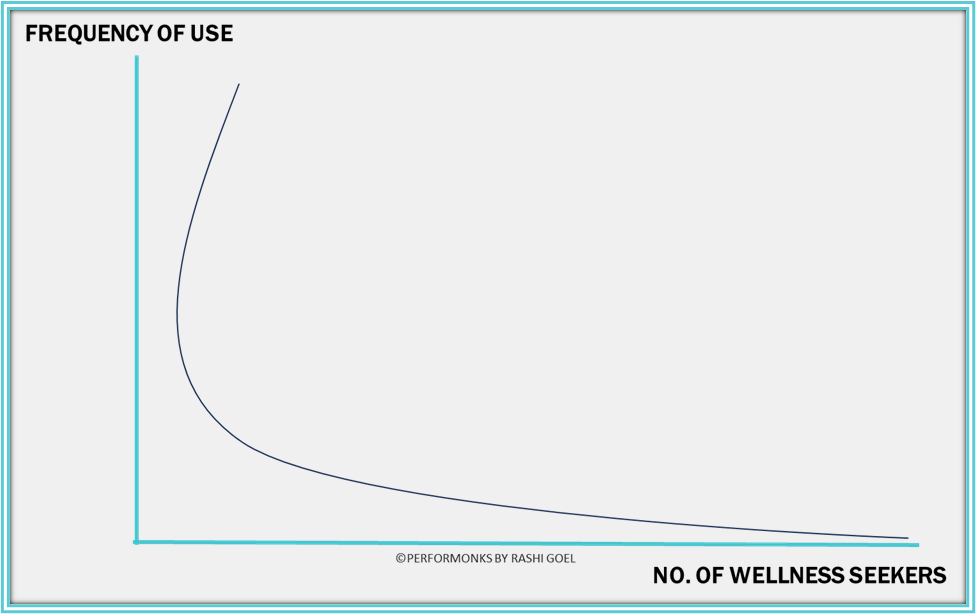Cult-fit Part II
Wellness category users are generally light users. If this 'Made In India' business pivots to 'Made For India', not only it might accelerate growth, but more Indians might get fitter
Ideas that help marketers do better and be better. Subscribe here. Check out my other essays on marketing here.
Welcome to Part II of the Cult.fit thesis.
In the previous edition, we saw that even though 100,000 worked out daily with Cult-fit during the lockdown, it still has a whopping 66X potential in metro cities.
But how to get there?
That’s what this edition covers.
Five ideas that set the stage
Four unsolved consumer tensions
Three resultant ideas for Cult.fit
1. Five ideas that set the stage.
1.1. Indians are not too healthy. Physically and mentally.
We know that India is the diabetes capital of the world.
But this is just the tip of the iceberg.
In urban India, 33% of men and 44% of women are either overweight or obese [ICMR]. By 2025, India will have 48.3 million obese people (World Obesity Federation], and 17 million obese children [The Paediatric Obesity Report]. India is also the most depressed country in the world followed by China and America [WHO] (!). [source]
I am convinced that improving our healthspan is as critical as reversing climate change and erasing misogyny.
In my opinion, Cult.fit has the unique combination of resources and leadership necessary to take up this mission.
1.2. Cult.fit, with the Tata Digital partnership is well-positioned to increase the health span of Indians.
When all the apps under Tata Digital are stitched together, this health super-app can be our daily health partner.
Envision the user experience with me. The user fills in a lifestyle questionnaire and what she ate in the last 24 hours. She gets her medical tests done. Then, a team of experts create a personalized lifestyle plan for her - what to eat, when to eat, what supplements to take, and further tests if needed. Also, an easy workout plan to start with and most importantly, they educate her on ‘why’ and ‘how’ the plan will help her meet her health goals.
The journey continues:
Care.fit and 1mg can schedule quarterly health tests, add supplements to her shopping cart and also schedule appointments with the right doctors close to where she lives.
Cult.fit can curate workout videos for her. She always has the option to work out at the gym, at home, with her friends or with a personal trainer.
Mind.fit can surface meditation and mindfulness videos for her, structured by duration - 2 min, 5 min, 10 min and so on.
Big Basket can recommend healthy recipes, meal suggestions and seasonal vegetables to her health needs.
Cult.sport can offer fitness equipment and clothes for her body type.
1.3 The user can enter the ecosystem through any app, then travel horizontally or go deeper
While the ideal place for a user is to start with a personalized lifestyle plan, the beauty of this synergistic service suite is that she can enter the ecosystem at any place. Then with the help of intelligent nudges and gamification, she could move
horizontally - gets medical tests done and then buys the recommended iron-rich grocery for her anaemia
or go deeper - she takes two free trial classes at Cult.fit, moves to virtual workouts at home with a trainer, and walks on Sundays with the Cult.fit community).
Technology integration is already a gargantuan task. But you know what’s tougher than climbing Mount Everest in slippers? User motivation.
1.4. The wellness category is a victim of the knowing-doing gap
Our wellness habits peak with good intentions on 1st Jan and ebb with the gravity of inertia.
This is not a surprise.
A 2019 Times of India study found that even though 46% of the respondents said a healthy lifestyle is their top priority, only 37% of them actually exercised.
A 2017 research (~1.06 million 20-35-year-olds) by Gympik found that 53% felt they lack the motivation and discipline to maintain a regular fitness regimen.
Combine this with the low annual income levels of our users (Rs.3,24,000 annual income per household) and we are looking at a long tail of value-seeking light users.
1.5 A subscription bundle pricing
The business will need to maximize light users on the one hand and at the same time, create incentives for them to keep coming back, i.e. be inconsistently consistent.
One way to cater to value-seeking light users is to have ‘sachet pricing’. Cult.fit’s Rs.125/- per month virtual workouts offer that.
Another way is to give them flexibility. Again, the ‘pause membership’ feature does that.
A third way is to offer free trials.
But I think some sort of subscription model like Amazon Prime or Netflix one that offers bundled freebies might be a good direction to explore.
Now onto the second part of the analysis. What unsolved tensions do the fitness culture and content reveal?
2. A wide sweep of our wellness culture and fitness content reveals three unsolved tensions.
2.1. The drinking from a firehose issue
The user is not lazy. Just under-educated and confused.
When it comes to fitness, there are 4.8 billion search results on Google. Not only is there a massive amount of information, but much of it contradicts each other. One study suggests that 10,000 steps a day are sufficient for fitness, while another claims that without 30 minutes of strength training three times a week, our bodies will age faster. One day ghee is considered good, and the next day olive oil is said to be better.
Behaviour change is already hard. This confusion makes it even harder.
The issue does not end here.
In addition to being contradictory, the abundance of information is not personalized.
What we truly need is a trustworthy expert who can guide us without judgment and provide a fitness solution that aligns with our lifestyle.
2.2. The Peacock perfection complex
Our social media feeds are full of images of people with six-pack abs and chiselled bodies. I like to call them "peacock athletes." These are early adopters of fitness who have figured out the right exercise and diet routine that works for their bodies. Now that they are happy with their own appearance, they want to showcase it to everyone.

If you type "fitness" in the Instagram search bar, you'll understand what I'm talking about. It's an endless stream of incredibly fit bodies.
While I applaud these athletes, I worry about their impact on fitness culture. For every "peacock" athlete, there are 10,000 unfit individuals who feel overwhelmed by these unattainable images of perfect fitness. They become discouraged and don't even take the first step.
Social media and fitness brands promote idealized bodies and emphasize strength training as the only path to fitness. This scares away beginners.
What we truly need are relatable bodies, achievable workouts, and realistic fitness journeys. Check out these IG pages of creators sharing their very real journeys. (here, here and here)



2.3. We are ignorant together
We are a social culture. Therefore, fitness is a communal activity for many Indians - we gather for laughter yoga and take morning walks together.
When it comes to good habits, a community keeps us motivated.
But because birds of a feather flock together, chances are that we are also ignorant together.
So, how can we preserve the social aspect of wellness but also incorporate a trusted expert into the mix?
2.4. The ‘what is water?’ problem:
So, there are these two young fish, swimming along, and they pass an older fish. The older fish asks them, "Hey guys, how's the water?" The two young fish just nod and keep swimming. Later on, one of them turns to the other and asks, "What the heck is water!?"
We Indians suffer from a ‘what is water’ problem when it comes to our wellness heritage. We've got yoga, martial arts, fasting, fermented foods for a healthy gut, vegan diets, pranayam - it's always been here, while we blindly adopt Western ideas of fitness!
This for me, was the surprising insight of this entire study.
There are so many videos, like the one below, sharing long-forgotten Ayurvedic home remedies for better health.
We have a suite of HIIT, meditative martial arts and fitness routines. Some people are are trying to preserve this knowledge. Look at this video of a modernised version of the Akhada workout.
There are grassroots brands like Tagda Raho, that are reviving traditional Indian workouts. Tadga Raho has modernised and patented traditional fitness equipment like the mudgar and the gada so they can be used by all genders and body types.
What we truly need is a national brand with the resources to synthesize and modernise our traditional fitness knowledge and routines.
If you have made it till here, then you are ready to look at the three ways in which Cult.fit could address these tensions.
3. Three ideas for Cult.fit
3.1. Mantra of progress, not perfection
As we saw earlier, light users get overawed by perfect bodies and perfect workouts that dominate social media.
Cult.fit will need to start living and breathing the ‘progress over perfection’ mantra. And this is the mantra. ‘The most effective form of exercise is the type that someone will consistently perform’. This means, being active is more important than doing the perfect exercise. And walking 100 more steps every day is more important than running a marathon.



A study shows that Indians are into simple exercises; 67 per cent take brisk walks, 26 per cent practice yoga and 11 per cent play team sports. Only 10 per cent are into strength training.
That’s why, Cult.fit will need to meet the user where he or she is. The ‘brisk walk’ segment might be motivated to become a part of Cult.fit if they are asked to start carrying light dumbells on their walks or wear a weighted backpack. We will lose them if we ask them to start lifting weights on day one.
Gamification can get users to keep coming back for more. The energy meter gives a rank and energy points for each workout. It could start tracking progress over time, so an athlete feels a sense of accomplishment. Another idea could be that of Streaks. Snap pioneered Streak to track how often two users chat with one another. The more days in a row friends chat, the longer their streak becomes. This feature cleverly encourages daily usage because we don’t want to lose our streak!
3.2. Lean on Cult.ambassadors to recruit and motivate users
A community of power users has played a major role in scaling Notion to 20 million users. Ben Lang, was a Notion evangelist. He spent his weekends working on Notion and talking about it to anybody who cared to listen.
Sure enough, Notion hired Ben as their Head of Community.
The first thing Ben did was create an Ambassador program. His idea was that if he was crazy enough to spend his free time helping Notion, there were probably others just as crazy out there. He just had to find them.
But here's the catch: Notion ambassadors don’t get paid. Because it could affect their authenticity. Ambassadors volunteer purely out of love for Notion.
There are passionate fitness and wellness experts all over India. Could they be motivated to help rescue 6.6 million out of indifferent and scary health outcomes? Maybe yes. Would they do it for free? I don’t think so.
But what I do know is that we like to work out in groups, that too outside a gym. Having an expert-led community will make it easier for us to stay on track and steer us away from naive mistakes.
Why I also like the Cult.ambassador idea is because truly passionate wellness enthusiasts build their wellness practice slowly and through deep study. They are able to recognize what trips us and recommend practical hacks - like using the same playlist of songs to get into the workout mood, stacking habits into our daily routine, and wearing workout clothes to bed so we feel ready for a workout when we wake up etc.
This is the kind of experience that will make Cult.fit and the wellness habit stick.
3.3. Make for India, don’t just be Made in India
This is super important. But also super tough.
Could the experts at Cult.fit dig into our treasure trove of Ayurveda, Patanjali, Ved-Puranas, Kalaripayattu, Akhara routines, Yoga, and Meditation techniques and develop holistic wellness solutions suited for our weather, diets, health needs and lifestyles?
The market for their existing boxing, yoga and functional and strength training routines will continue. But could we expand the fitness market if we offer Bhangra Aerobics, S&C with a Mudgar ( I would love to do this), or a 21-day Yoga and Pranayam practice for people with Vata nature?
Bear with me as I further imagine what this might look like. Could recommended meal plans be different for the sweltering Delhi summer vs the temperate Bangalore climate? Could Cult.store sell us Jal Neti pots and have a Jal Neti Kriya reminder notification pop up in the morning? Could Cult.fit send us balanced meal plans for Navratra fasts and Kuttu atta recipes?
If this happens. This might broaden its offerings beyond what they have now - more choice might mean more users and more usage. And it will definitely help Cult.fit differentiate itself from the glut of West influenced fitness content out there.
What do you think Cult.fit should do to get 6.6 million Indians fitter?
Thanks for reading. See you next time!










